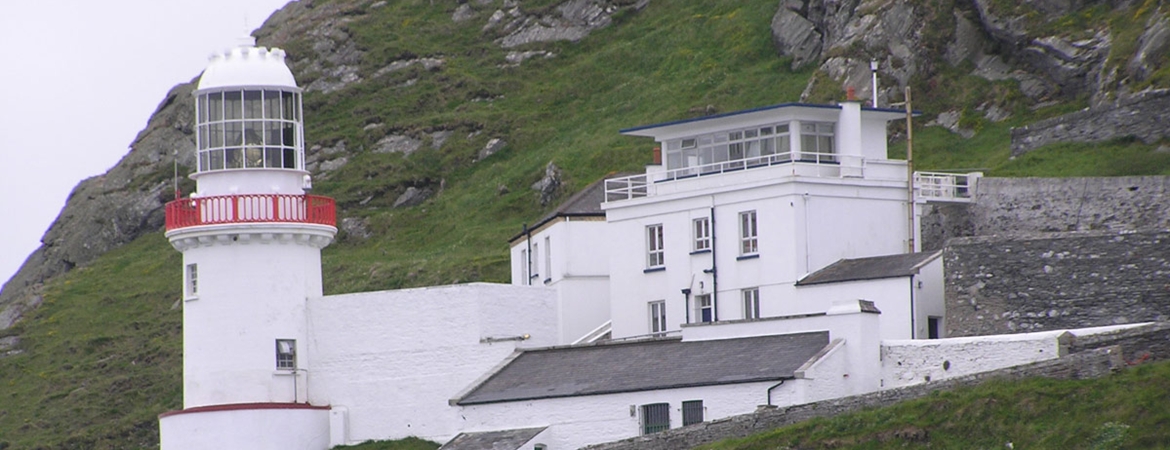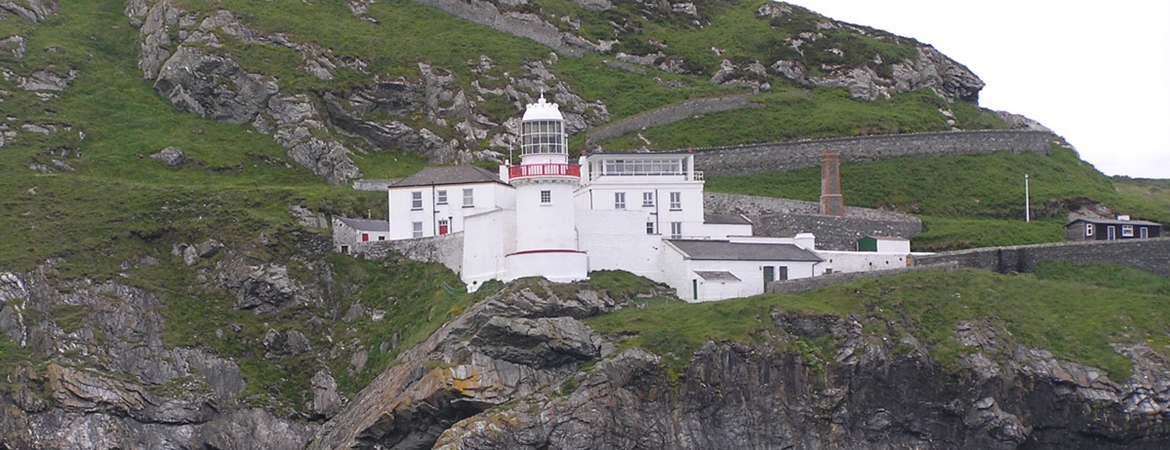Cill Mhantain or Mantan's church is named after a disciple of Saint Patrick and according to the Annals of Clonmacnoise, Mhantain (the toothless) landed with Saint Patrick near Wicklow in 432 AD before heading north to Strangford Lough. Unfortunately for Mhantain, he lost his front teeth by a blow of a stone from one of the Celtic pagans who had come down from the hills to oppose the landing of Saint Patrick.
Wicklow is derived from the Viking name Wykylo or Viking's Loch. The creek 4 km (2.5 miles) long is separated from the open sea by a long narrow grassy spit of low land known as the Murrow or Murragh. The creek made an excellent harbour of refuge for the Norse sea-rovers and indeed, subsequent mariners. The present harbour piers were not built until much later with a small local authority lighthouse on the east pier established in 1884.
Wicklow Head, 84 metres (275 feet) high, lies 3km south east of the town of Wicklow past the ruins of Maurice Fitzgerald's Anglo-Norman Blackcastle.
Two lighthouses, one on Long Hill, the other on the saddle of the head, were built by the Revenue Commissioners to the design of John Trail their engineer, who previously had been involved with the Grand Canal Company between 1769 and 1777. The two lights were established on 1st September 1781. They not only marked the headland but prevented mariners from confusing Wicklow Head with Howth and Hook Head, both of which had single lights. The two lights at Wicklow also gave a lead west-north-west between the south end of the India Bank and the north end of the Arklow Bank, and more locally through the Wicklow Swash to the anchorage off Wicklow tower or the coastal channel to Dublin.
Each octagonal stone tower support an eight sided lantern of which the five seaward sides were glazed with a number of 'bulls-eye' panes and a dome covered each lantern. The light source in each lantern was twenty tallow candles at the focus of a large mirror reflector.
The rear tower is extant, minus its lantern but with a brick protecting dome which was added in 1866. The tower is approximately 29 metre high to the balcony. As no trace or drawings exist of the front tower on the headland saddle, one can only presume that it was similar to the rear tower, possibly not as high and definitely, according to a report dated March 1812, had a eight foot diameter lantern. Again in 1816 another report stated '. . . and the second which is a smaller one in a proportionable degree'.
Soon after the Corporation for Preserving and Improving the Port of Dublin took over the lights from the Revenue Commissioners in 1810, the Wicklow Head lights were considered for rebuilding at a lower level due to the fact that the rear or upper light was liable to be obscured by fog; also both lights were in a very dilapidated condition. The lanterns were rotten and rusty and the reflectors tarnished. An attempt was made to improve the reflectors by cementing small pieces of looking glass in the large catoptric reflectors with six candles placed in their assumed focus.
Approval to build two new lighthouses was obtained from Trinity House and the Lord Lieutenant in 1816, and work commenced before the end of the year. Mr George Halpin, the Board's Inspector of Works, designed and supervised the building of the lighthouses which was carried out by the Board's tradesmen. Both towers were erected on the same bearing as the 1781 towers, with the new upper lighthouse close to the old front tower and the new front lighthouse tower down the cliff, 37 metres above high water level.
The new lights were fixed, each lantern housed fifteen Argand oil lamps and reflectors supplied by Messrs Greenside Company of Edinburgh and were established soon after 12th November 1818. The 1781 front tower was completely demolished and at the same time the rear light was discontinued but the tower remained, forming a useful landmark by day.
The approximate overall heights of the two new towers were: upper (rear) 75 feet (22.8m) and lower (front) 45 feet (13.7m). Both towers were painted white.
Soon after the new lights were established, the Board agreed with Inspector George Halpin's report that the two existing keepers, Leonard Manley and George Wilkinson, be replaced as they were unqualified for any of the newly constructed lighthouses; they were also to surrender their dwellings. Mr C. Dudgeon, the Wicklow Lighthouses' Collector and Inspector should be informed that his services were unnecessary but should be paid to the end of the present quarter, December 1818. All three men appealed on the grounds of long and faithful service; the Board awarded the two keepers pensions of £15 per annum and Dudgeon received £50 in respect of his twenty years service.
Three years later, in 1821, the Revenue Commissioners, who from 1796 to 1810 had managed the lighthouses, thought they could re-instate their Preventive Water Guard along with a flag mast and take over the two ex-lightkeepers' 'cabins' at the station. The Revenue Commissioners were told that Regulations of the Service prevented the Board from complying with their request. (Messrs Halpin, Bigger and Baker had noted in their report to the Board dated 21st September 1810 that the underpart of the large Wicklow Head Lighthouse was appropriated for the use of the officer who commanded the Signal Station. When the guard was withdrawn is not known, probably soon after the Corporation took over.)
On the night of 10th October 1836 lightning struck the old back tower and in the ensuing fire the lantern and all floors were completely gutted. Mr Halpin stated in his report that as the tower formed a useful landmark by day, he recommended that it should be re-roofed next Spring. It is interesting to note here that it was not until 1866 that the present brick dome was added.
On 30th June 1865 a new lightvessel, known as the Wicklow Swash, was established off the Head and the upper or rear light was discontinued. This exercise was the result of one of the recommendations of the Committee, set up in 1863, to improve the lighting of the south east coast between Kish and Tuskar. The vessel had a fixed red light. Its life was comparatively short and was withdrawn on 10th October 1867 when the Codling and North Arklow lightvessels were established.
Coinciding with the discontinuance of the upper light in June 1865, the lower light was improved; the 1818 lantern was replaced by a cast iron lantern supplied by Messrs J. Edmundson & Co., Dublin and the fixed catoptric apparatus was replaced by a Chance Brothers, Birmingham, first order dioptric lens with a revolving shade to give an occulting character of ten seconds flash every fifteen seconds. The oil lamp was supplied by Messrs W. Wilkins, London, to the design of Captain Nesbit, Trinity House.
Following the success of Mr. J.R. Wigham's experiment with gas at the Baily Lighthouse in 1865, the light at Wicklow was converted to oil gas on 4th January 1868. The gas was made in a small gas works attached to the station; later the gas was made from cannel coal. The occulting character was effected by a gas valve being turned on for ten seconds and off for three. In reality, the gas was not completely turned off, it was lowered to an almost invisible point before being raised for the ten second "flash". If by chance the lowered flame did go out, a by-pass light re-ignited the main flame. Altogether there were 108 jets each with 20 fish tail jets. Thus it was possible to employ lights of five different powers. The resultant flame produced by the jets was concentrated into a mica funnel set at the focal point of the lens.
Gas continued to be used until 21st August 1906 when the light source was converted to incandescent paraffin vapour using a 50mm diameter mantle. The optic was also replaced by a Chance Brothers third order revolving apparatus driven by a David Brown clockwork rotation machine, giving three flashes every ten seconds.
The station became relieving on 1st October 1974. It was then completely modernised and the light converted from the paraffin to electric on 31st March 1976. Two months later, the Codling and Arklow lightvessels were withdrawn and replaced by Lanby buoys which were monitored by the Keepers in the Watch Room, built on top of the Keepers' quarters. They are now monitored by remote link to the Lighthouse Depot in Dun Laoghaire.
A radiobeacon was established on 5th April 1978. In more recent times utilisation of radio direction finders by mariners has been, to a great extent, superseded by more modern technology. For this reason the Commissioners discontinued their Medium Frequency Radiobeacon service at Wicklow Head on 1st April 1992 and at all stations on the 1st February 1999.
On 31st March 1994 the lighthouse was converted to automatic operation and the keepers were withdrawn from the station. The station is in the care of an Attendant and the aids to navigation are also monitored via a telemetry link from Irish Lights Dun Laoghaire.
Before concluding, it is interesting to note that the upper 1818 tower and what were the two keepers cottages were leased from 1891 to the Admiralty (Coast Guard); Board of Works who took over in 1922, one or two private lessees; and from 1935 until 1942 the Irish Youth Hostel Association. On 1st May 1996 the Irish Landmark Trust leased the octagonal tower for a period of 35 years. This tower is now being used as a holiday home.
Wicklow Head Lighthouse
|
Position: |
52°57.947' North 05°59.889' West |
Aids to Navigation |
|
|
Sectors: |
|
|
Height of Tower: |
14 metres |
|
Height of Light MHWS: |
37 metres |
|
Character: |
Fl (3) W 15s |
|
Range: |
18 nautical miles |
|
Radar Beacon: |
|
|
AIS: |
|
Tags :
Wicklow
,
Wicklow Head





